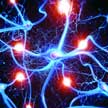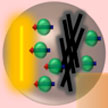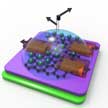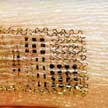Showing Spotlights 753 - 760 of 2780 in category All (newest first):
 Notwithstanding the progress neuroscientists have made in understanding the microscale function of single neurons and the macroscale activity of the human brain - a comprehensive understanding of the brain still remains an elusive goal. Here we review the basic concepts associated with neuroscience and the current journey of nanotechnology towards the study of neuron function by addressing various concerns on the significant role of nanomaterials in neuroscience and by describing the future applications of this emerging technology.
Notwithstanding the progress neuroscientists have made in understanding the microscale function of single neurons and the macroscale activity of the human brain - a comprehensive understanding of the brain still remains an elusive goal. Here we review the basic concepts associated with neuroscience and the current journey of nanotechnology towards the study of neuron function by addressing various concerns on the significant role of nanomaterials in neuroscience and by describing the future applications of this emerging technology.
Oct 18th, 2017
 Currently, most graphene-based innovations are not yet at the level of large-scale commercial production. But public and private investments into graphene and its applications in products are large and whichever production methods eventually turn out to be successful, exposure to humans or the environment somewhere along the value chain or life-cycle of the material or product should be anticipated timely. A new review paper offers suggestions on how potential nanospecific safety issues can be addressed, by who and at what stage of the innovation process.
Currently, most graphene-based innovations are not yet at the level of large-scale commercial production. But public and private investments into graphene and its applications in products are large and whichever production methods eventually turn out to be successful, exposure to humans or the environment somewhere along the value chain or life-cycle of the material or product should be anticipated timely. A new review paper offers suggestions on how potential nanospecific safety issues can be addressed, by who and at what stage of the innovation process.
Oct 16th, 2017
 Hydrogen bond base pairing forces are essential for the mechanisms associated with DNA stability. Despite attracting great research attention, this fundamental interaction has eluded a precise physical description so far since its electrical origin has not been quantified yet. Researchers now have proposed characterization by means of electrical forces, providing a framework for universal characterization of hydrogen bonds. In this way, they provide technical arguments to support that hydrogen bonds are well distinguishable and their role in biological events require a proper specific intrabond description.
Hydrogen bond base pairing forces are essential for the mechanisms associated with DNA stability. Despite attracting great research attention, this fundamental interaction has eluded a precise physical description so far since its electrical origin has not been quantified yet. Researchers now have proposed characterization by means of electrical forces, providing a framework for universal characterization of hydrogen bonds. In this way, they provide technical arguments to support that hydrogen bonds are well distinguishable and their role in biological events require a proper specific intrabond description.
Oct 10th, 2017
 Just like traditional paper origami that results in complicated 3D structures from 2D paper, graphene origami allows the design and fabrication of carbon nanostructures that are not naturally existing but of desirable properties. In a new report, researchers describe how p-type and n-type doping of 2D sheets like graphene in selected areas could be exploited as two 'colors' to guide the sheets into preferred folded shapes where complementarily doped areas maximize their mutual overlap.
Just like traditional paper origami that results in complicated 3D structures from 2D paper, graphene origami allows the design and fabrication of carbon nanostructures that are not naturally existing but of desirable properties. In a new report, researchers describe how p-type and n-type doping of 2D sheets like graphene in selected areas could be exploited as two 'colors' to guide the sheets into preferred folded shapes where complementarily doped areas maximize their mutual overlap.
Oct 6th, 2017
 Among the important parameters in optical lithography is the spatial resolution you can get and the time you need to draw your pattern. Systems with regular and fixed patterns can be extremely fast but those systems are based on masks. Mask production is a time consuming and expensive process. So-called mask-less systems can draw unorganized patterns directly on substrates, at the cost of longer process times. Researchers now have presented a new lithographic approach with a high-resolution, low-cost technique based on nanosphere lithography.
Among the important parameters in optical lithography is the spatial resolution you can get and the time you need to draw your pattern. Systems with regular and fixed patterns can be extremely fast but those systems are based on masks. Mask production is a time consuming and expensive process. So-called mask-less systems can draw unorganized patterns directly on substrates, at the cost of longer process times. Researchers now have presented a new lithographic approach with a high-resolution, low-cost technique based on nanosphere lithography.
Oct 4th, 2017
 Chemical engineering researchers have reported the usage of activated carbon prepared from tea leaves, improving the mass transport phenomenon (33 % performance improvement) in an operating direct methanol fuel cell, owing to its pore structure characteristics. The cell performance underwent drastic changes in the mass transport region of the fuel cell polarization curve, comparable to the standard membrane electrode assembly. This is attributed to the pore structure of this framework aiding in enhanced water removal, as a result more air molecules react with the platinum catalyst sites finally improving the fuel cell performance.
Chemical engineering researchers have reported the usage of activated carbon prepared from tea leaves, improving the mass transport phenomenon (33 % performance improvement) in an operating direct methanol fuel cell, owing to its pore structure characteristics. The cell performance underwent drastic changes in the mass transport region of the fuel cell polarization curve, comparable to the standard membrane electrode assembly. This is attributed to the pore structure of this framework aiding in enhanced water removal, as a result more air molecules react with the platinum catalyst sites finally improving the fuel cell performance.
Oct 3rd, 2017
 Electrocatalysis offers important opportunities for clean fuel production, but uncovering the chemistry at the electrode surface remains a challenge. Here, this work exploits a single-nanosheet device to perform in-situ measurements of water oxidation electrocatalysis and reveal a crucial interaction with oxygen. The obtained in-depth understanding could provide valuable clues for catalysis system design and the in-situ measurement could be also useful to analyze other interfacial reaction processes.
Electrocatalysis offers important opportunities for clean fuel production, but uncovering the chemistry at the electrode surface remains a challenge. Here, this work exploits a single-nanosheet device to perform in-situ measurements of water oxidation electrocatalysis and reveal a crucial interaction with oxygen. The obtained in-depth understanding could provide valuable clues for catalysis system design and the in-situ measurement could be also useful to analyze other interfacial reaction processes.
Sep 29th, 2017
 Nanotechnology materials are going to open new realms of possibility for flexible and stretchable monitoring gadgets that are wearable directly on the skin. Here we look at the latest developments in a class of electronic devices, commonly referred to as electronic skin, epidermal electronics, or electronic tattoos, from the materials, devices, and medical applications perspectives. While such devices can also be used for prosthetics and rehabilitation, optogenetics, and human-machine interfaces, this review focuses on the properties of the materials that enable skin-mounted sensors for use as diagnostic tools in the medical field.
Nanotechnology materials are going to open new realms of possibility for flexible and stretchable monitoring gadgets that are wearable directly on the skin. Here we look at the latest developments in a class of electronic devices, commonly referred to as electronic skin, epidermal electronics, or electronic tattoos, from the materials, devices, and medical applications perspectives. While such devices can also be used for prosthetics and rehabilitation, optogenetics, and human-machine interfaces, this review focuses on the properties of the materials that enable skin-mounted sensors for use as diagnostic tools in the medical field.
Sep 26th, 2017
 Notwithstanding the progress neuroscientists have made in understanding the microscale function of single neurons and the macroscale activity of the human brain - a comprehensive understanding of the brain still remains an elusive goal. Here we review the basic concepts associated with neuroscience and the current journey of nanotechnology towards the study of neuron function by addressing various concerns on the significant role of nanomaterials in neuroscience and by describing the future applications of this emerging technology.
Notwithstanding the progress neuroscientists have made in understanding the microscale function of single neurons and the macroscale activity of the human brain - a comprehensive understanding of the brain still remains an elusive goal. Here we review the basic concepts associated with neuroscience and the current journey of nanotechnology towards the study of neuron function by addressing various concerns on the significant role of nanomaterials in neuroscience and by describing the future applications of this emerging technology.
 Subscribe to our Nanotechnology Spotlight feed
Subscribe to our Nanotechnology Spotlight feed





